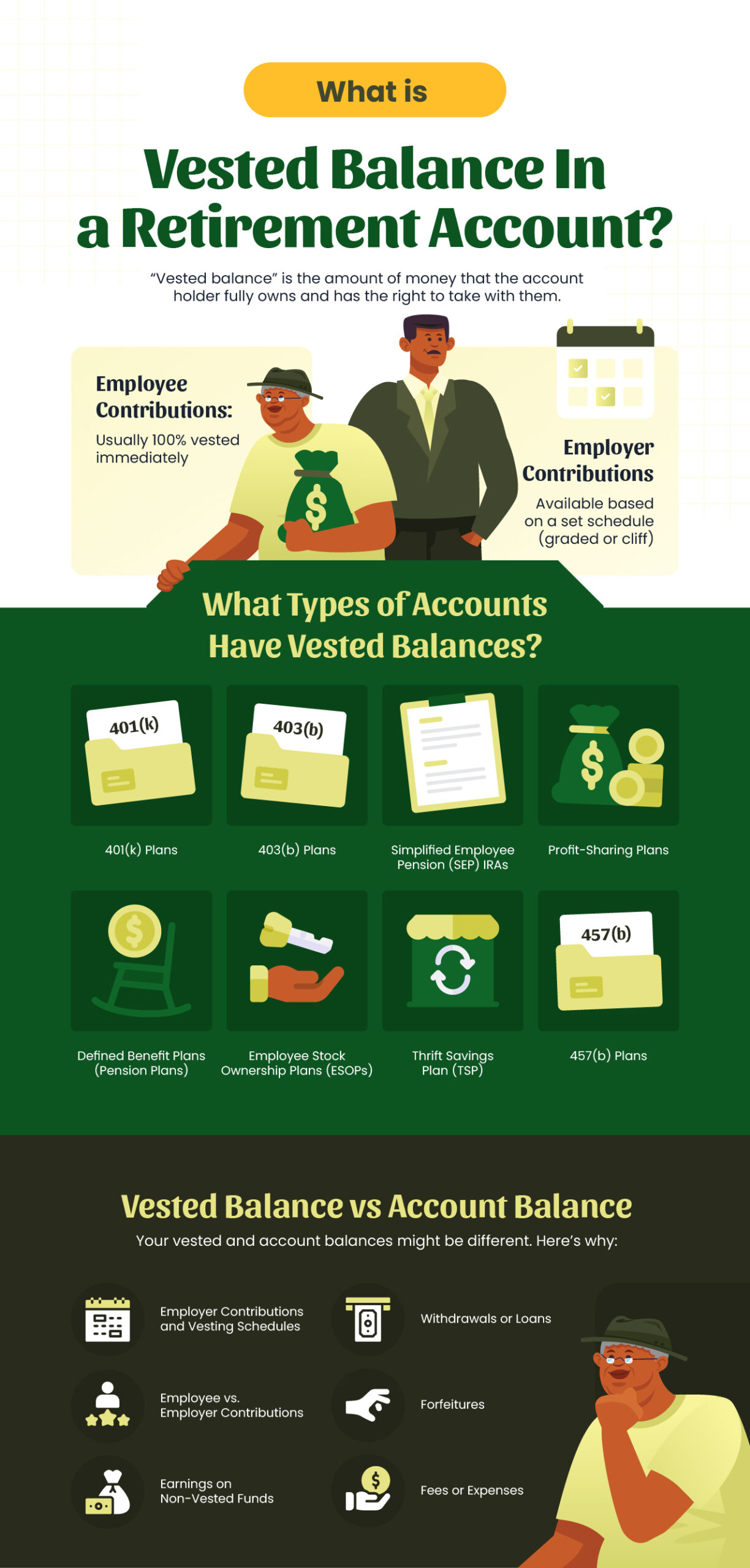As fee-only financial planners, we help clients understand their retirement accounts and the terminology that comes with them. One concept that often causes confusion is the “vested balance”—a number that may not match the total account balance. Below, we break down what this means and why it matters.
What Does Vested Balance Mean?
A vested balance in a retirement account is the portion of money that the account holder fully owns and can take with them, even if they leave their employer. This is especially relevant in retirement plans that include employer contributions, such as 401(k)s or pension plans. Most of these plans use a vesting schedule, which determines when employer-contributed funds officially become the employee’s.
Here’s how it generally works:
- Employee Contributions: Anything an employee contributes from their own paycheck is usually 100% vested right away. This means the employee always has full ownership of the funds they personally contribute.
- Employer Contributions: These may follow a vesting schedule. Some employers allow immediate vesting, while others use a graded or cliff schedule.
- Graded Vesting: Ownership of employer contributions increases gradually over time (for example 20% after two years, 40% after three years, and so on until 100%).
- Cliff Vesting: Ownership jumps to 100% all at once after a set number of years, with no vesting before that point.
Once fully vested, the funds are yours to keep, even if you leave your job. If you leave earlier, you forfeit the unvested portion of employer contributions.
What Types of Retirement Accounts Have Vested Balances?
Vesting applies to retirement accounts that involve employer contributions. Here are the types of retirement accounts where you might encounter vested balances, and what the withdrawal rules are like:
- 401(k) Plans: These are employer-sponsored retirement plans where both employees and employers can make contributions. Many employers offer matching contributions up to a certain percentage of the employee’s salary. The employer’s contributions can be subject to a vesting schedule.
- 403(b) Plans: Similar to 401(k) plans but designed for employees of public schools, certain tax-exempt organizations, and certain ministers. They can also have vesting schedules for employer contributions.
- Simplified Employee Pension (SEP) IRAs: Typically used by small businesses and self-employed individuals. The employer is the sole contributor to a SEP IRA. Depending on the plan, there might be a vesting schedule for these contributions.
- Profit-Sharing Plans: In these plans, employers share a portion of their profits with employees by contributing to their retirement accounts. These contributions can be subject to vesting schedules.
- Defined Benefit Plans (Pension Plans): These are traditional pension plans where employees receive a set benefit in retirement. The benefit is typically based on salary, years of service, and a set formula. Employees might need to work a certain number of years to be vested in these benefits.
- Employee Stock Ownership Plans (ESOPs): These plans allow employees to become owners of stock in their company. Like other employer-provided benefits, there can be a vesting schedule before the employee fully owns the shares.
- Thrift Savings Plan (TSP): This is a retirement savings and investment plan for federal employees and members of the uniformed services. There can be a vesting schedule for certain types of contributions, especially those received as part of agency or service automatic and matching contributions.
- 457(b) Plans: These are deferred compensation plans for certain state and local government employees and non-governmental entities. If employer contributions are made, they might be subject to a vesting schedule.
It’s important to note that not all employers use vesting schedules—some allow immediate ownership of contributions.
Vested Balances In Equity Compensation
Incentive Stock Options (ISOs) and Restricted Stock Units (RSUs) are forms of equity compensation that can also be subject to vesting. They are commonly used in companies, especially tech and startups, as part of employee compensation packages.
Incentive Stock Options (ISOs):
ISOs grant employees the right to purchase a certain number of shares of the company’s stock at a fixed price (the “strike price”) after a specified vesting period.
- Vesting: Like other forms of stock compensation, ISOs often come with a vesting schedule. Employees might have to stay with the company for a certain number of years to fully exercise all of their options. Often, there’s a “cliff” of one year, meaning no options are vested until after the first year, followed by monthly or quarterly vesting thereafter.
- Tax Implications: ISOs have potential tax benefits. If held for a specific duration after exercise (at least two years from the grant date and one year from the exercise date), the gains may qualify for long-term capital gains tax instead of ordinary income tax.
Restricted Stock Units (RSUs):
RSUs are company shares that are promised to an employee through a vesting plan and distribution schedule after achieving required performance milestones or after remaining with their employer for a particular time.
- Vesting: RSUs will vest at predetermined times, often annually, over a period of 3-4 years. Once vested, the company typically distributes the shares or the cash equivalent.
- Tax Implications: RSUs are taxed when they vest. The total value of the vested RSUs (based on the stock’s market value) is considered as ordinary income. Employers often “withhold” a portion of the RSUs to cover the tax liability, so employees might receive fewer shares than the number that vested.
Both ISOs and RSUs are tools companies use to retain and incentivize employees, tying part of their compensation to the company’s success and stock performance. As with any compensation or financial tool, it’s important for recipients to understand the terms, vesting schedules, and tax implications and to consult with a financial advisor when making decisions regarding these assets.
Why Is My Vested Balance Different From My Account Balance?
Your vested balance may be different from your account balance in a retirement account due to the vesting schedule applied to employer contributions. Here are some reasons why these two balances might not match:
- Employer Contributions and Vesting Schedules: As mentioned earlier, many retirement plans have vesting schedules for employer contributions. If you’re not fully vested, a portion of the employer’s contributions and any associated earnings won’t belong to you yet, even though they appear in your account balance.
- Employee vs. Employer Contributions: All of your personal contributions (and the earnings on those contributions) are usually 100% vested immediately. This means you always have full ownership of the funds you personally contribute. However, the funds your employer contributes on your behalf might be subject to a vesting schedule.
- Earnings on Non-Vested Funds: The earnings on non-vested employer contributions are also subject to the same vesting schedule. So if you’re 50% vested, you would only have a right to 50% of the earnings on the employer contributions, even though all the earnings would show up in the total account balance.
- Withdrawals or Loans: If you’ve taken out any loans or made withdrawals from your retirement account, it can impact your account balance. However, the vested balance would only reflect the amount you’re entitled to based on the vesting schedule and any remaining funds.
- Forfeitures: If you leave your job before you’re fully vested, the non-vested portion of the employer contributions (and their respective earnings) will be forfeited. While these funds might have been included in your total account balance previously, they would be removed once you’re no longer with the company, impacting the vested balance.
- Fees or Expenses: Some retirement accounts have fees or expenses that are deducted from the account balance. Depending on the specifics of your plan, these may affect both your total account balance and your vested balance.
Put simply: your account balance is the total amount in the account, while your vested balance is the amount you’re entitled to keep right now.
It’s always a good idea to review your retirement account statements carefully and consult with your plan administrator or a New Jersey financial advisor if you have questions about your balances.
Should I Withdraw From My Vested Balance?
Even if you can access your vested balance, withdrawing early isn’t always wise. You may face taxes, penalties, and reduced long-term growth. In most cases, it’s better to let the funds grow tax-deferred until retirement. Always consider your financial goals and consult a financial advisor before making decisions.


